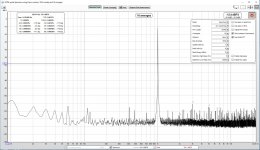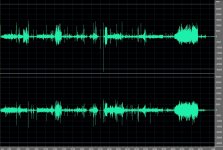^ Is this supposed to be a serious inquiry or just an honest effort to make a fool out of oneself?
One, the Pono hasn't exactly rocked the world, nor is its performance any better than some of the high end phones. Second, let's count the number of people taking advantage of the balanced. Third, with as much storage and unlimited data plans as available, are interchangeable SD cards that useful (I have a 128 in my S7, whoop-de-doo)? Fourth, I generally need a phone, but don't need another pocket doohickey cluttering up my life.
Give me better playback in a phone, please. I hardly doubt I'm alone in this mindset, which is why it hasn't been a commercial success.
One, the Pono hasn't exactly rocked the world, nor is its performance any better than some of the high end phones. Second, let's count the number of people taking advantage of the balanced. Third, with as much storage and unlimited data plans as available, are interchangeable SD cards that useful (I have a 128 in my S7, whoop-de-doo)? Fourth, I generally need a phone, but don't need another pocket doohickey cluttering up my life.
Give me better playback in a phone, please. I hardly doubt I'm alone in this mindset, which is why it hasn't been a commercial success.
Which cell phones have balanced outputs, interchangeable Micro SD cards, Ayre electronics, and are readily available for less than $150?
None that do -70dB THD either. I assume you are talking about a used PONO, wasn't the MSRP $399? The PONO's failure was an inevitability in fact typing pono into google did not place it anywhere near the top a dead giveaway.
Last edited:
The worst industrial design I have ever seen from a music player, plus the Ayre snake oil and craptastic music service. Wonder why it failed?
My Pono players are not used for portability. They function as preamps with an excellent DAC to feed hi-res files in balanced mode to a Wiener TPA3118 or a TI TPA3255EVM. I too use a phone for portability. The only time I use a Pono as a portable is on long flights. It was a lifesaver to and from China.
Granted, most people aren’t feeding balanced/differential signals to class D chip amps. There are many better things to strap to your arm during a jog, but they can’t do for me what a Pono does. Pono was doomed from the outset, but I still love mine.
Granted, most people aren’t feeding balanced/differential signals to class D chip amps. There are many better things to strap to your arm during a jog, but they can’t do for me what a Pono does. Pono was doomed from the outset, but I still love mine.
Last edited:
I think the micro mem card is important feature to have with anyone's portable thingy. I dont expect the PONO or iApple stuff for music to be SOTA. I use it when traveling... exercising … car ... all noisy environment places anyway. and generally the earphones are crap .... most of them... at any price.
I have never tried the bal I/O feature which maybe lower thd but I dont care because of the noisy environment. I got one for 2 reasons... large battery and long playing time and replaceable mem.
THx-RNMarsh
I have never tried the bal I/O feature which maybe lower thd but I dont care because of the noisy environment. I got one for 2 reasons... large battery and long playing time and replaceable mem.
THx-RNMarsh
Last edited:
If a man speaks in the middle of the forest
and there is no woman around to hear him,
is he still wrong?
🙂
and there is no woman around to hear him,
is he still wrong?
🙂
Maybe not, but he is still in danger of being thumped out - depending on what he said.
-Chris 🙂
-Chris 🙂
I have a sansa clip with rockbox firmware and etymotic ER4s. Blocks out sound, long battery, replaceable memory card and cheap enough not to care if it breaks. Perfect travel companion.
If a man speaks in the middle of the forest
and there is no woman around to hear him,
is he still wrong?
🙂
Oh, the sense of guilt!
Of course he is


George
Any one know how to design an all fet phono stage? High cmrr, uld and low noise.... CFB Amp, high slew rate?
🙂
-RNM
🙂
-RNM
Any one know how to design an all fet phono stage? High cmrr, uld and low noise.... CFB Amp, high slew rate?
🙂
My no feedback all FET one sounds fine to me. ULD for phono why bother? Open-loop phono is inherently bandwidth limited so slew rate is virtually meaningless. People tend to overlook the fact that ticks and pops are not pre-emphasized so are much less of an issue than some think. See plot of both sides of a well made LP, only the needle drop (and here it is a drop) near the middle even pushes the limit. There is nearly a crest factor of 10 but only 2dB headroom lost to pops.
Note - this plot is 45min long so each point represents about 350,000 samples and the peak value is displayed so no peaks are missed but the width of a tick or pop is visually exaggerated by 350K.
Attachments
Last edited:
OK. Well, guess we are done with phono stage design. What's next?
I am working on a cross-over filter to replace the existing Crown amp/filter for the M2. But instead of using analog opamps, I am using DSP (miniDSP) instead. It has been well known and published in AES by several authors that there is a distortion rise approaching the corner freq using typical opamp type circuits. I was reminded again by D. Self in his new filter book. The DSP method doesnt do that.
View attachment filter dist 3.PDF
The miniDSP with output opamp changed to OPA1612 has harmonics at -120dbv..... almost good enough ;-)
-RNM
I am working on a cross-over filter to replace the existing Crown amp/filter for the M2. But instead of using analog opamps, I am using DSP (miniDSP) instead. It has been well known and published in AES by several authors that there is a distortion rise approaching the corner freq using typical opamp type circuits. I was reminded again by D. Self in his new filter book. The DSP method doesnt do that.
View attachment filter dist 3.PDF
The miniDSP with output opamp changed to OPA1612 has harmonics at -120dbv..... almost good enough ;-)
-RNM
Last edited:
I have a sansa clip with rockbox firmware and etymotic ER4s. Blocks out sound, long battery, replaceable memory card and cheap enough not to care if it breaks. Perfect travel companion.
I have one too, and it plays flac and other lossless compression files!
The miniDSP with output opamp changed to OPA1612 has harmonics at -120dbv..... almost good enough ;-)
It won't connected to those DAC's. You could socket it and start rolling and add to the metadata unless you want to DBT (which I know you won't do).
More papers from the days of uA741's, 301's, etc. you need an update.
Last edited:
It won't connected to those DAC's. You could socket it and start rolling and add to the metadata unless you want to DBT (which I know you won't do).
More papers from the days of uA741's, 301's, etc. you need an update.
Error correction line #7273 .... OPA1612 is on the input. My comment is 'measured' results.
Update doesnt change the results of those analog filter configs.… as recently also shown by D.Self in his new filter book.
The miniDSP also does any needed EQ. 🙂 I'll get all the coeff of the JBL filter and use them.
Intermediate test is to tap out of the Crown amp/xover at it's amp input and use new analog amps. Eventually, to be replaced with miniDSP and new analog PA.
-RM
Last edited:
Error correction line #7273 .... OPA1612 is on the input. My comment is 'measured' results.
OK then the A/D or are you using the miniDSP in bypass mode? George has already done some measurements IIRC. Or you could see Tom's (Mr. more zeros is better himself) MiniDSP 4x10 HD Performance Measurements.. I doubt the op-amp swap would make up the difference.
Open-loop phono is inherently bandwidth limited so slew rate is virtually meaningless.
My observation is that way to many High End Audio Priests don't understand the "slew rate" concept. They conflate and confuse "slew rate" with "rise time".
And if you try to explain, you'll realize they don't understand the difference between small signal and large signal. And the show goes on, to the very basics of physics, where they can debate (or so they think) "quantum".
Last edited:
They conflate and confuse "slew rate" with "rise time".
They do?
Two different things.
-RM
OK. Well, guess we are done with phono stage design. What's next?
Funny place to say that, don't you think?
Personally these days I'm into the entertainment value of simple DIY. I see what some folks do here custom wound transformers, CNC cabinets, custom heat sinks, etc. all wonderful stuff but not for me at this point in time. 90% of the music for me is the content and another 9.9% has been the speakers in some cases. There are dozens of valid approaches they are all "accurate" to someone.
Here are the five necessities for a system from an audiophile with 50yr. of experience, vast knowledge of numerous genres of music, and who enjoys listening as well as tweaking.
1. The Analogue source should be an Idler-Drive turntable (or a Reel-To-Reel Tape Deck)
2. A Moving-Coil (or Strain-gauge or Optical?) cartridge
3. The Digital source should use the highest quality (OEM) Esoteric Transport that is affordable
4. The Electronics should be Separates, and using Tubes, with the one possible exception of the bass amplifiers
5. The Speakers must be HIGH-EFFICIENCY AND BOTH Bi-ampable AND SET-Friendly
Last edited:
- Status
- Not open for further replies.
- Home
- Member Areas
- The Lounge
- John Curl's Blowtorch preamplifier part III

